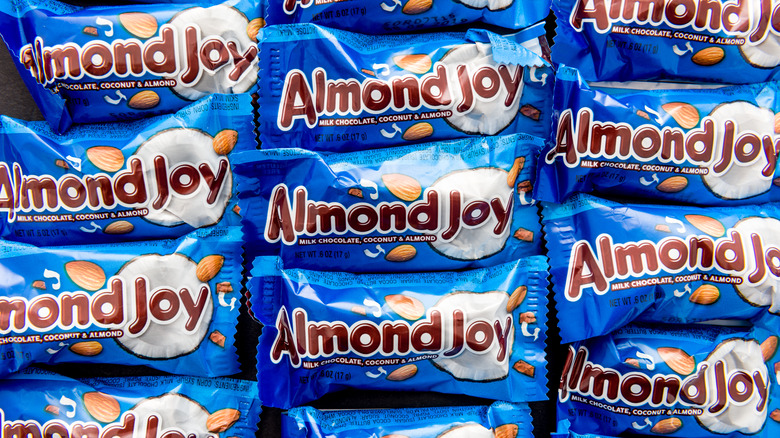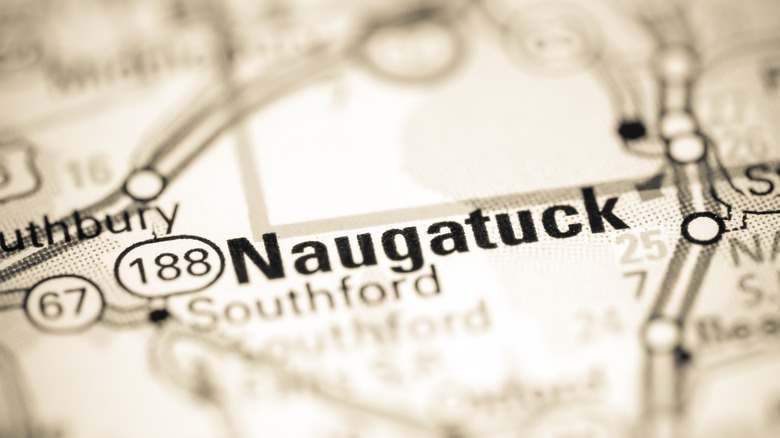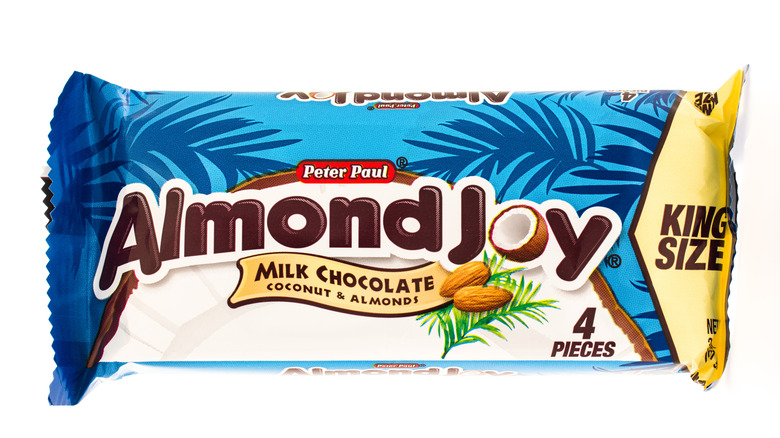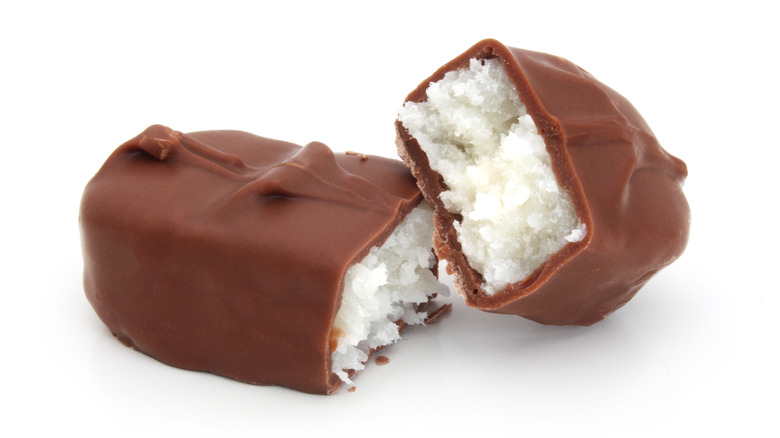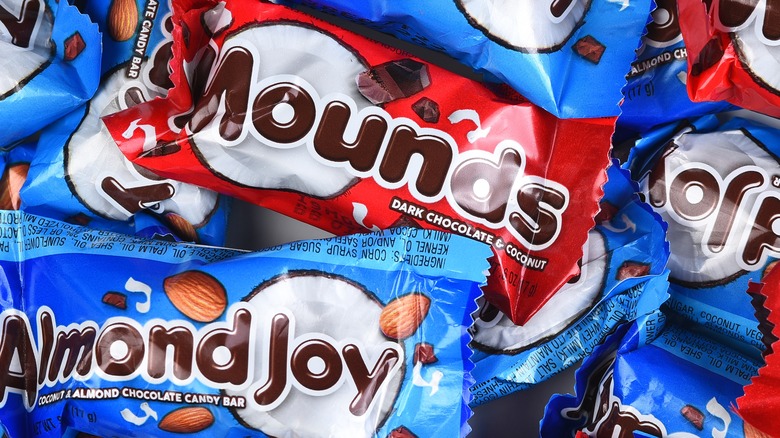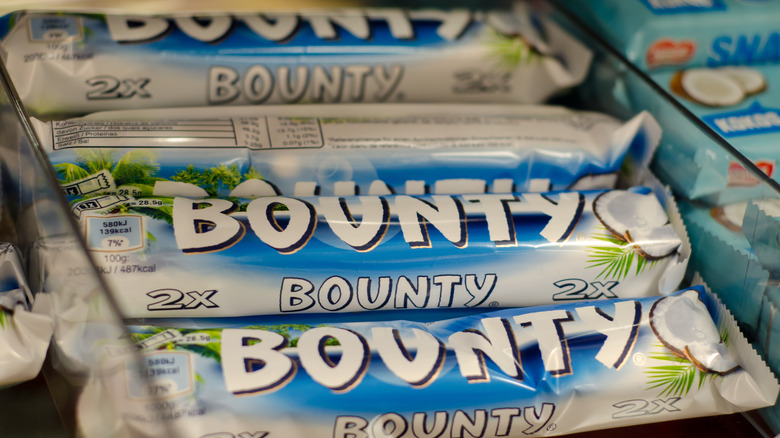The Untold Truth Of Almond Joy
We may receive a commission on purchases made from links.
If you love coconut and chocolate, you're almost certainly a Mounds or Almond Joy fan. Or why not both? These candy bar classics, developed by the same company, have long been favorites in the grocery store candy aisle. The former, invented in the 1920s, paved the way for the latter, made with milk chocolate and almonds.
While Almond Joy has been an American candy classic since it was first invented in the 1940s, it actually boasts a rather circuitous evolution. How did Almond Joy shed its Armenian roots? Why does its presence on the U.S. market mean that Americans do not know the distinct pleasure of a Bounty bar? And how did it emerge from its roots as the product of a small family company in New England to become one of the headliners of Hershey?
For the answers to these questions and more, here's everything you need to know about Almond Joy (and its close cousin Mounds).
Almond Joy was first invented in Connecticut
Don't let the tropical aroma of its coconutty filling fool you: Almond Joy has very New England roots. It was in Naugatuck, Connecticut that candy seller Peter Paul Halajian founded the Peter Paul Candy Company in 1919, and it was here, more than two decades later, that the almond-studded, chocolate-covered coconut bar would be invented.
But we're getting ahead of ourselves, here.
Upon his arrival in the U.S. in 1890, Peter Halajian first found work at a rubber factory, though he long had dreams of working for himself. He later opened his own fruit and candy business with his daughters, and, after years of selling door-to-door and to commuters at the train station, they finally opened their own shop on Water Street in Naugatuck. He would later involve his brother and brother-in-law in the business and develop it into a small chain of sweets shops and, finally, a manufacturing company.
The inventor changed his name to Peter Paul
Born in Armenia in 1864, Peter Halajian realized quickly that his foreign last name was not going to be a good selling point in his new American business. According to Connecticut Explored, it was because his customers had a hard time pronouncing Halajian that he legally changed his last name to Paul.
But despite the name change, Peter Paul didn't forget his roots! He often employed Armenian immigrants at his company, and indeed, all of the original founders and the first stockholders were from his native Armenia.
Once he had changed his name, he began using it professionally. Indeed, Peter Paul became, not just his name, but the name of his candy company — the Peter Paul Manufacturing Company — in 1919. He gained acclaim when he was commissioned by the U.S. Army to produce chocolate for American troops abroad, and this name soon became synonymous with quality candy.
Almond Joy's roots are in Mounds
While Peter Paul's candy company has roots in the early 20th century, it wasn't until the 1940s that Almond Joy was invented — and for this, we have Mounds to thank.
In its early days, Peter Paul made many different candy bars, including two with coconut. Konabar, a combo of chocolate, coconut, nuts, and fruit, was the first unique product made and sold by the company, according to Connecticut Explored. Mounds, meanwhile, was invented in 1921: a simple combination of a coconut filling coated in dark chocolate that would prove not only to be a sketch for Almond Joy but also the company's most popular bar.
Given the success of Mounds, Cal Kazanjian, who was named president of the company when Paul passed away in 1927, decided to specialize rather than diversify. He opted in the late '20s to discontinue most of the company's other products to focus on best-selling Mounds, which was tedious to produce, as the company had been thus far, by hand. Kazanjian developed automated machines to facilitate their production, and business flourished. In the '30s, Peter Paul became the world's largest consumer of coconuts, and this development would later make producing Almond Joy even easier.
From a marketing standpoint, Almond Joy has long been compared with Mounds
Almond Joy was first developed in 1948 as a replacement for Dreams Bars, which was a bar made by Peter Paul with coconut and diced almonds. But in reality, Mounds is a far more apt comparison for Almond Joy. Both candies come in packages of two smaller bars and boast the same rich coconut filling. The devil is in the details. Almond Joy uses milk chocolate where Mounds boasts dark, and Almond Joy also has a little extra on top, evident in its name: a whole almond. The almond is coated in chocolate before being added to the bar and coated again; this protects the almond from growing too soggy and gives chocolate lovers a double dose of chocolate!
The two bars have long been compared to one another or even jokingly pitted against one another from a marketing standpoint. Almond Joy and Mounds are packaged in similar wrappings, with the former being blue and the latter red, and advertisements often compare the two.
An ad jingle comparing the two is now in the advertising hall of fame
One of the most enduring examples of the comparison between Almond Joy and Mounds comes from the Peter Paul company itself, which produced an ad in 1970 that seemed to be pitting the two bars against one another.
"Sometimes you feel like a nut, sometimes you don't / Almond Joy's got nuts / Mounds don't."
The jingle was written by Leo Corday and Leon Carr and quickly became a pervasive earworm. Even today, people who grew up listening to the jingle can recall it with ease! It might seem strange to pit two of your products against one another in this way, but according to Ask Any Difference, the idea of using one ad to advertise two candy bars was an efficient and economical choice for the company. In 2002, the jingle was even inducted into the Advertising Slogan Hall of Fame.
Almond Joy is now produced by Hershey
Peter Paul soon began to outgrow its roots as a small family company, and in 1978, it was acquired by Cadbury Schweppes — producer, among other things, of the Cadbury Creme Egg. While the manufacturing facilities remained in Naugatuck, the British candy company slowly began removing mentions of the New England town from the candy bar's packaging.
In 1988, when Hershey's acquired the U.S. operations of Cadbury, so, too, did Peter Paul's products acquire the Hershey brand. (This applied not just to Mounds and Almond Joy, but also to York Peppermint Patties, acquired by Peter Paul in 1972!) After over 80 years of candy production in Connecticut, Hershey finally closed the original Naugatuck plant in 2007; today, the bar is produced in Virginia, reports Connecticut Explored.
These days, much like it does with its other products, Hershey produces multiple sizes of Almond Joy, including king-size, snack-size, and more. Almond Joy is also available in some Hershey mixed bags of miniatures.
The popularity of Mounds and Almond Joy kept Mars from introducing Bounty in the U.S.
Travel to the native land of Cadbury, and you'll find a slightly different coconut chocolate bar on the market. British Bounty, which, much like Almond Joy and Mounds, unites two small bars in one package, combines the milk chocolate coating of Almond Joy with the almond-less coconut center of Mounds — although a dark chocolate version of the bar is also available — pretty much the same thing as a Mounds!
Given the similarities between the two, it's perhaps no surprise that, according to Candy Blog, Mars' attempts to push their Bounty bar into the American market have been in vain, as Mounds and Almond Joy have fairly decisively cornered that market. So add Bounty to British Milky Way, Smarties, Mars, and more as candies that you might have to head across the pond to find!
